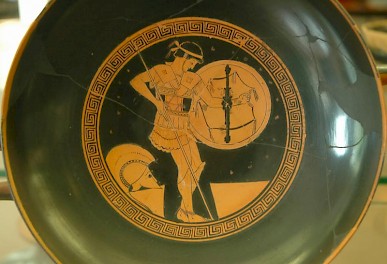Aigospotamoi (6)
Aigospotamoi: the final battle of the Peloponnesian War (431-404). In September 405, the Athenians were decisively defeated by the Spartans and lost their navy. As a result, the siege and fall of Athens became inevitable.
Conditions: The armies

The Athenians came to Aigospotamoi with about 180 triereis, including the Paralus, a state triere employed for public missions. Each triere had a crew of approximately 200 members, twenty of which would be hoplites or officers, and the rest oarsmen. The officers and hoplites were all Athenian citizens, recruited from all layers of Athenian society. The oarsmen would predominantly be non-Athenian mercenaries. Despite the heavy cost of the Peloponnesian War, Athens had managed to keep its fleet in reasonable condition - although, it must be said, by increasingly counting on mercenaries. Herein lay a grave danger. For the loyalty of the mercenaries was dependent on the height of the sum and on the regularity of pay. And as the war continued, Athens began to experience more and more difficulties in meeting these requirements. Sparta, trusting on Persian gold, was often able to attract oarsmen at the expense of Athens. Nevertheless, the Athenian fleet can be considered the more experienced of the forces at Aigospotamoi.
The Athenian fleet was commanded by at least six admirals: Conon,note Philocles,note Menander, Tydeus, Adeimantus and Cephisodotus.note Ehrhardt and Wylie suggest a seventh admiral, by the name of Eryximachus, was present at the battle.note This is based on a fragment from one of Lysias' orations. From the text can be concluded that Eryximachus was more than a simple participant in the battle and was in fact a admiral. The absence of Eryximachus in our other sources does not necessarily imply that he was not present at the battle. It could simply be accredited to his insignificant role during the fight.
The most experienced of the admirals was Conon. In 413 he had already commanded an Athenian squadron and in 411/410 he had been elected admiral. Conon's democratic inclinations seem to have made him the darling of the Athenian demos. Philocles does not appear to have had prior military experience. Menander had commanded Athenian troops prior to the Aigospotamoi campaign, though he seems never to have completed any of his missions successfully. Above all he is known for his failed attempt to break through the maritime blockade at Syracuse in 413 as well as for his reckless confrontation of the Corinthian fleet, which caused many losses. Tydeus was a veteran of the Sicilian Expedition too. But it was not as a admiral that he participated: that honor was reserved for his father Lamachus. So the first time Tydeus held a command was at Aigospotamoi. The most relevant fact about Adeimantus is probably his close relationship to Alcibiades. Both were representatives of the same deme, and their dynastic ties had a long history. As for admiral Cephisodotus, nothing is known about him, unfortunately.note
All admirals had the same rank, but supreme command rotated on a daily basis. On the day of the battle it was Philocles' turn. The advantage of the rotating system is quite obvious: the more admirals, the greater the cumulative experience. The various admirals at Aigospotamoi, though, being newly promoted, seem to have brought with them little cumulative experience. A possible disadvantage was that disagreement could lead to inactivity or that misplaced competitiveness among the admirals would prevent proper cooperation. At the time of Aigospotamoi the disadvantages seem to have preponderated. There most certainly was discord between Philocles and Adeimantus over a controversial law which Philocles had persuaded the demos into accepting. Moreover, the well-known Athenian political rivalries persisted during the campaign. In particular the sudden appearance of Alcibiades strained the already tense relationship between Adeimantus on the one side and Conon, Tydeus and Menander on the other.note
Considerably less is known on the size of the Spartan fleet. No concrete evidence has been found. On account of Xenophon, Hellenica 2.2.5, however, it is assumed that the Spartan fleet was of similar in size to the Athenian fleet. The passage asserts that Lysander, after the battle of Aigospotamoi, was in command of 200 ships. Taking into account the probability that Lysander would press undamaged, overpowered Athenian ships and crews into his service, one might conclude that the Spartan fleet must have been of a strength equal to that of the Athenian force prior to the battle. In my opinion, though, the absence of actual numbers of Athenians ships seized, makes this presupposition too speculative. An argument considered by Kagan, however,note to substantiate the fact that Lysander's fleet was of comparable size, does appeal to me. He asserts that Lysander had set up camp in the well-supplied harbor of Lampsacus. If his fleet in actual fact had been conspicuously smaller, he would never have left this strong defensive position to accept battle.
As mentioned above, Aracus was navarch in name only, but the actual supreme command was in the hands of Lysander. Considering that Spartans were allowed to hold the position of navarch only once in their career, they might be expected to be less experienced than their Athenian colleagues. Lysander was well aware of this, and was of the opinion it applied to him as well. At least, this can be concluded from his aversion to offer battle. The first time he commanded a fleet, at the battle of Notium, he adhered to a defensive tactic. He did the same during the Aigospotamoi campaign. Beside Aracus, Lysander was assisted by Eteonicus. His abilities had earned him the command of a Spartan squadron in an earlier campaign. His experience in warfare and his leadership would prove valuable assets to Lysander.